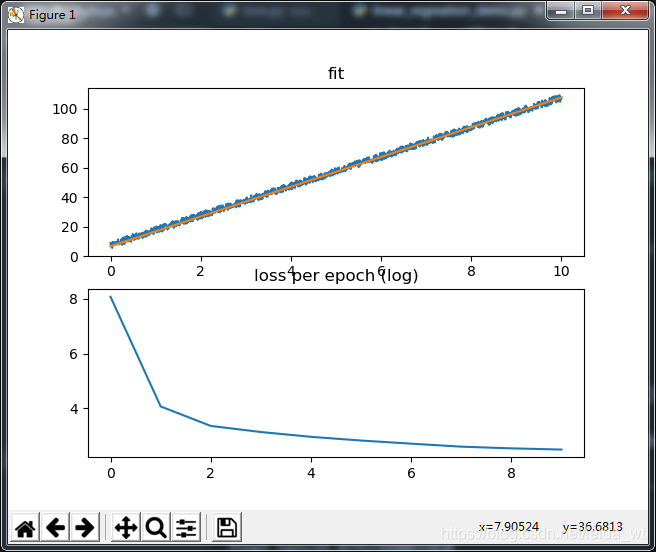版权声明: https://blog.csdn.net/leida_wt/article/details/84962593
本文通过实现简单的回归来入门下numpy与pytorch
dataSet文末给出
线性回归
线性回归是个古老的问题了,对于线性回归,就是简单找到一组w使得目标函数能最好的拟合数据集X,这个好定义为总均方误差最小。线性回归的解析解数学课本已经给出,证明也不困难,简单的解一个矩阵方程即可。具体可见https://blog.csdn.net/Fleurdalis/article/details/54931721,
一个关键点是矩阵求导法则,除此之外就仅为一个简单的求最值问题
numpy版本
这里用纯numpy以梯度下降求一下
#! python3
# -*- coding:utf-8 -*-
# 单变量线性回归 梯度下降法
import numpy as np
import pandas as pd
import matplotlib.pyplot as plt
plt.rcParams['font.sans-serif'] = ['SimHei'] # 用来正常显示中文标签
plt.rcParams['axes.unicode_minus'] = False # 用来正常显示负号
class Linear_regration_single:
def __init__(self, data, alpha=0.01, theta=None, step=1500):
"""初始化线性回归类
Arguments:
data {str} -- 数据集地址
Keyword Arguments:
alpha {float} -- 学习步长 (default: {None})
theta {float} -- 起始theta[t0,t1] (default: {None})
step {int} -- 迭代步数 (default: {None})
"""
self.cost_history = []
self.df = pd.read_csv(data)
self.m = len(self.df) # 数据总数
# 学习率
self.alpha = alpha
# thetas
if theta is None:
self.theta = np.array([0, 0]).reshape(2, 1)
else:
self.theta = np.array(theta).reshape(2, 1)
# 迭代数量
self.steps = step
self.x = np.array(self.df['x']).reshape(self.m, 1)
self.y = np.array(self.df['y']).reshape(self.m, 1)
self.X = np.hstack((np.ones((self.m, 1)), self.x)) # 补充为其次形式
def h(self):
"""预测函数
Returns:
np.array -- θ0+θ1*x向量
"""
return np.dot(self.X, self.theta)
def predict(self, x):
"""预测函数对外接口
Arguments:
x {float} -- x值
Returns:
y -- 预测
"""
return self.theta[0, 0]+self.theta[1, 0]*x
def J(self, theta=None):
"""cost function
Returns:
float -- cost
"""
if theta is None:
# 默认内部theta
return np.sum((self.h()-self.y)**2)/(2*self.m)
else:
# 计算给定的theta cost
return np.sum((np.dot(self.X, theta)-self.y)**2)/(2*self.m)
def descend_gradient(self):
"""以梯度下降更新theta
"""
for i in range(self.steps):
#print(self.theta, self.J())
self.cost_history.append(self.J()) # 记录cost
# 更新theta
derta = np.dot(self.X.T, (self.h()-self.y))*self.alpha/self.m
self.theta = self.theta-derta
def closed_solution(self):
"""封闭解
Returns:
np.array -- theta封闭解
"""
from numpy.linalg import inv
return np.dot(np.dot(inv(np.dot(self.X.T, self.X)), self.X.T), self.y)
def plot(self):
"""绘制结果
"""
fig = plt.figure()
ax1 = fig.add_subplot(211) # 高1 宽2 图号1
ax2 = fig.add_subplot(212) # 高1 宽2 图号2
ax1.scatter(self.x, self.y, label='skitscat',
color='k', s=25, marker="x")
line_x = [min(self.x), max(self.x)]
line_y = [self.predict(x) for x in line_x]
ax1.plot(line_x, line_y)
ax1.set_xlabel('x')
ax1.set_ylabel('y')
ax2.plot(self.cost_history)
ax2.set_xlabel('迭代次数')
ax2.set_ylabel('cost')
ax1.set_title('单变量线性回归梯度下降')
plt.show()
def info(self):
print('decent method solution:')
print('final cost: '+str(self.J()))
print('theat: '+str(self.theta))
print('closed solution:')
print('final cost: '+str(self.J(self.closed_solution())))
print('theat: '+str(self.closed_solution()))
if __name__ == "__main__":
data_dir = './ex1data1.txt'
t = Linear_regration_single(data_dir)
t.descend_gradient()
t.info()
t.plot()
可观测到与封闭解的结果还是很接近的
decent method solution:
final cost: 4.964362046184745
theat: [[-1.58199122]
[ 0.96058838]]
closed solution:
final cost: 4.476971375975179
theat: [[-3.89578088]
[ 1.19303364]]

pytorch版本
pytorch version=0.4.1
下面的版本是以pytorch实现的,借助自动求导,只要定义好前向计算方法和loss即可。
import numpy as np
import torch.utils.data
import torch as t
import matplotlib.pyplot as plt
t.manual_seed(1) # reproducible
fig = plt.figure()
# 首先造出来一些带噪声的数据
N = 1100
x = t.linspace(0, 10, N)
y = 10*x+5+t.rand(N)*5
ax1 = fig.add_subplot(211) # 高2 宽2 图号1
ax1.plot(x.numpy(), y.numpy())
# 从Tensor构建DataSet对象
data = t.utils.data.TensorDataset(x, y)
# 随机分割数据集,测试集
train, test = t.utils.data.random_split(data, [1000, 100])
# 建立dataloader shuffle来使得每个epoch前打乱数据
trainloader = t.utils.data.DataLoader(train, batch_size=100, shuffle=True)
testloader = t.utils.data.DataLoader(test, batch_size=100, shuffle=True)
# 定义模型参数 for y_head=w@x+b
w = t.rand(1, 1, requires_grad=True)
b = t.zeros(1, 1, requires_grad=True)
optimizer = t.optim.SGD([w, b], lr=0.03, momentum=0.6)
#optimizer = t.optim.Adam([w,b],lr=10)
loss_his = []
batch_loss = 0
for epoch in range(10):
for i, (bx, by) in enumerate(trainloader):
bx = bx.view(1, -1) # torch.Size([100])->torch.Size([1,100])
y_head = w@bx+b
loss = 0.5*(y_head-by)**2
loss = loss.mean()
batch_loss += loss.item()
optimizer.zero_grad() # 先清除梯度
loss.backward()
optimizer.step()
#print('training:epoch {} batch {}'.format(epoch,i))
loss_his.append(batch_loss)
batch_loss = 0
def main():
print('w={},b={}'.format(w.item(), b.item()))
y_head = w*x+b
ax1.plot(x.numpy(), y_head.detach().numpy().flatten())
ax1.set_title('fit')
print('final_loss={}'.format(loss_his[-1]))
ax2 = fig.add_subplot(212) # 高2 宽2 图号2
ax2.set_title('loss per epoch (log)')
ax2.plot(np.log(loss_his))
plt.show()
if __name__ == '__main__':
main()

pytorch神经网络回归
借助神经网络的强大非线性能力,可以对任意曲线拟合,下面以拟合sin函数为例,定义了简单的全连接神经网络解决问题。
这里训练采用全局训练,未取batch
此外观察到采用BatchNorm之后训练稳定性明显提高,收敛略有提速
import numpy as np
import math
import matplotlib.pyplot as plt
import torch as t
from torch import nn, optim
import torch.utils.data
import torch.nn.functional as F
N = 1000
x = t.linspace(0, 2*np.pi, N)
y = t.sin(x)
#y = t.sin(x)+t.randn(len(x))/30
print('x.shape, y.shape:', x.shape, y.shape)
t.manual_seed(1)
class Dense(nn.Module):
# 自定义全连接层
def __init__(self, inshape, outshape):
super(Dense, self).__init__()
# 这里对w采用Xavier初始化(实为变种,仅考虑输入尺寸,这为普遍做法)
alpha = 1./math.sqrt(inshape)
self.w = nn.Parameter(t.randn(inshape, outshape)*alpha)
# 偏置的初始化0即可
self.b = nn.Parameter(t.zeros(outshape))
def forward(self, x):
return x@self.w+self.b
class NN(nn.Module):
def __init__(self, useDense=True):
super(NN, self).__init__()
if useDense:
# 使用自定义的全连接层
self.l1 = Dense(1, 20)
self.l2 = Dense(20, 40)
self.l3 = Dense(40, 1)
else:
self.l1 = nn.Linear(1, 20)
self.l2 = nn.Linear(20, 40)
self.l3 = nn.Linear(40, 1)
self.BN1 = nn.BatchNorm1d(20)
self.BN2 = nn.BatchNorm1d(40)
def forward(self, x):
out = self.l1(x.view(-1, 1))
out = self.BN1(out)
out = F.relu(out)
out = self.l2(out)
out = self.BN2(out)
out = F.relu(out)
out = self.l3(out)
return out
def predict(self, x):
with t.no_grad():
return self.forward(x)
net = NN()
iter_num = 500
criterion = nn.MSELoss()
#optimizer = optim.SGD(net.parameters(), lr=0.0005, momentum=0.9)
optimizer = optim.Adam(net.parameters(), lr=0.07)
loss_his = []
net.train()
for epoch in range(iter_num):
y_head = net.forward(x)
loss = criterion(y_head.view(-1), y)
loss_his.append(loss.item())
if loss.item() < 1e-5:
print('epoch=', epoch)
break
net.zero_grad()
loss.backward()
optimizer.step()
net.eval()
print('final loss:{}'.format(loss_his[-1]))
fig = plt.figure()
f1 = fig.add_subplot(211)
f2 = fig.add_subplot(212)
f1.plot(np.log10(np.array(loss_his)))
y_head = net.predict(x)
f2.plot(y.numpy())
f2.plot(y_head.numpy())
plt.show()

epoch= 192
final loss:9.999754183809273e-06
总结
- numpy的shape=(3,)与shape=(3,1)的数据是不同的,这在numpy中常会错,可考虑assert或注意归并操作的keepdim。
- numpy的sum等归并操作默认丢弃维数为1的维度,可指定keepdim=True或使用reshape方法。reshape不移动数据而是生成新的观察数据的方式,开销很小。
- plt.rcParams[‘font.sans-serif’] = [‘SimHei’] # 用来正常显示中文标签
plt.rcParams[‘axes.unicode_minus’] = False # 用来正常显示符号 - 对cost曲线取对数可看的更清楚些
- pytorch view 与 numpy的reshape等价,不会幅复制数据
- pytorch取计算图的Tensor并转numpy要注意先从计算图上取下,即调用detach方法
- 数据的归一化效果显著
- 对于pytorch里不需要记录梯度的计算,采用no_grad
def predict(self, x):
with t.no_grad():
return self.forward(x)
- numpy的计算值可用到单一cpu核,pytorch的blas后端已经做好了并行,通常可满载
data来自cs229的coursera板
链接: https://pan.baidu.com/s/1ibqIBTB7qTcq69EQ4qWcSw 提取码: 4jem